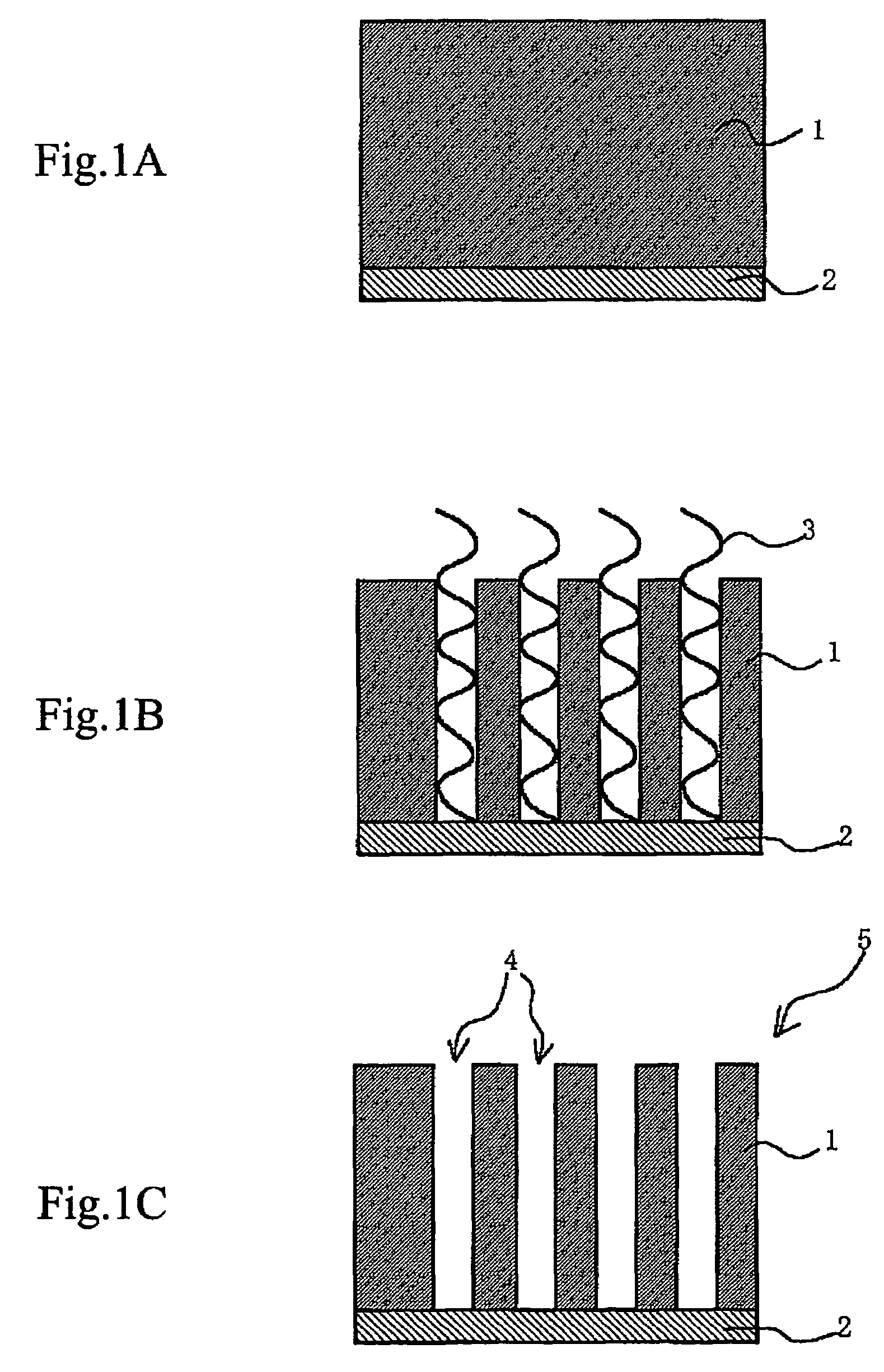Method of manufacturing micro structure, and method of manufacturing mold material
a microstructure and mold technology, applied in the field of producing microstructure and mold material, can solve the problems of difficult handling of materials, difficulty in controlling pore diameter, and use of fib disclosed in the past is nothing more than energy irradiation, etc., to achieve easy control of pore diameter and microstructure, and high positional resolution
- Summary
- Abstract
- Description
- Claims
- Application Information
AI Technical Summary
Benefits of technology
Problems solved by technology
Method used
Image
Examples
example 1
[0073]An aluminum substrate measuring 5 mm square was cut out of an aluminum sheet of high purity (99.999%). After degreasing with acetone and cleaning with ethanol, the aluminum substrate was fixed with a conductive paste and allowed to stand in a vacuum (approximately 10−5 Pa) for 30 minutes.
[0074]The aluminum substrate was irradiated with a Ga+ beam at an accelerating voltage of 30 kV and a beam current of 15 pA by using FB2000 (made by Hitachi). The beam was focused so that the beam diameter was 10 nm. It is to be noted that the Ga ion beam may be replaced by any other cation beam. The irradiating position of the ion beam was controlled within an error of ±5 nm by observing under an electron microscope. Irradiation with the ion beam was carried out to make pores, each measuring 10 nm in diameter and 2 μm in depth, at intervals of 20 nm, in the aluminum substrate. The rate of etching by irradiation was about 0.008 μm3 / s. The pore density was as high as 1.25×1011 pores / cm2. Incide...
example 2
[0079]An aluminum substrate measuring 5 mm square was cut out of an aluminum sheet of high purity (99.999%). After degreasing with acetone and cleaning with ethanol, the aluminum substrate was fixed with a conductive paste and allowed to stand in a vacuum (approximately 10−5 Pa) for 30 minutes.
[0080]The aluminum substrate was irradiated with a Ga+ beam at an accelerating voltage of 30 kV and a beam current of 15 pA by using FB2000 (made by Hitachi). The beam was focused so that the beam diameter was 20 nm. It is to be noted that the Ga ion beam may be replaced by any other cation beam.
[0081]The irradiating position of the ion beam was controlled within an error of ±5 nm by observing under an electron microscope. Irradiation with the ion beam was carried out to make pores, each measuring 20 nm in diameter and 2 μm in depth, at intervals of 100 nm, in the aluminum substrate. The rate of etching by irradiation was about 0.008 μm3 / s. The pore density was as high as 1.25×1011 pores / cm2.
[...
example 3
[0085]This example is intended to obtain the microstructure that would be applicable to the memory device.
[0086]First, an aluminum substrate measuring 5 mm square was cut out of an aluminum sheet of high purity (99.999%). After degreasing with acetone and cleaning with ethanol, the aluminum substrate was fixed with a conductive paste and allowed to stand in a vacuum (approximately 10−5 Pa) for 30 minutes.
[0087]Then, the aluminum substrate was irradiated with a Ga+ beam at an accelerating voltage of 30 kV and a beam current of 15 pA by using FB2000 (made by Hitachi). The beam was focused so that the beam diameter was 10 nm. It is to be noted that the Ga ion beam may be replaced by any other cation beam. The irradiating position of the ion beam was controlled within an error of ±5 nm by observing under an electron microscope. Irradiation with the ion beam was carried out to make pores, each measuring 10 nm in diameter and 2 μm in depth, at intervals of 20 nm, in the aluminum substrate...
PUM
| Property | Measurement | Unit |
|---|---|---|
| diameter | aaaaa | aaaaa |
| diameter | aaaaa | aaaaa |
| diameter | aaaaa | aaaaa |
Abstract
Description
Claims
Application Information
 Login to View More
Login to View More - R&D
- Intellectual Property
- Life Sciences
- Materials
- Tech Scout
- Unparalleled Data Quality
- Higher Quality Content
- 60% Fewer Hallucinations
Browse by: Latest US Patents, China's latest patents, Technical Efficacy Thesaurus, Application Domain, Technology Topic, Popular Technical Reports.
© 2025 PatSnap. All rights reserved.Legal|Privacy policy|Modern Slavery Act Transparency Statement|Sitemap|About US| Contact US: help@patsnap.com



